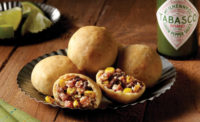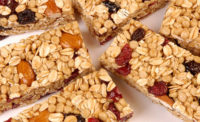Bakery snacks continue to innovate and grow through diversification
New flavors and more clean-label products rank high among trends related to doughnuts, pastries and muffins

courtesy of Cargill

courtesy of Flower Foods, Inc.

courtesy of California Walnut Commission

courtesy of Qualisoy

courtesy of Cherry Marketing Institute





Bakery snacks—including key segments like pastries, doughnuts, muffins, snack cakes and more—remain a staple in Americans’ snacking routines. Whether shoppers are looking for an indulgent snack or a better-for-you item, there’s something for everyone.
Top-level trends
Bakery snacks did well in 2017, increasing by 2.01 percent in dollar sales to $3.4 billion for the 52 weeks ending January 28, 2018, per IRI, Chicago. The most-notable growth came from Grupo Bimbo, up 9.98 percent to $227.8 million. Category leaders McKee Foods, private label and Hostess Brands all saw growth.
The pastry/doughnuts category—which includes doughnuts, pastry/Danish/coffee cakes and muffins—grew by 2.19 percent to $5.1 billion for the 52 weeks ending January 28, 2018. Of the three segments, muffins saw the most growth, up 9.78 percent in dollar sales to $1.1 billion. Private label led the way with 12.01 percent growth to $351.8 million, closely followed by Grupo Bimbo, up 17.43 percent to $341.7 million. McKee Foods also saw strong growth for its muffins, up 19.72 percent to $42.3 million, and Café Valley grew 15.86 percent to $29.8 million.
“While muffins may seem like an ‘old school’ snack, growth continues and muffins are now far more than just a bran or carrot muffin,” says Lance Aasness, executive vice president, Hinds-Bock Corp., Bothell, WA.
“One of the biggest trends we’re seeing in bakery snacks today is variety,” says David Roach, president of snacking/specialty business unit, Flowers Foods Inc., Philadelphia. “Whether it’s flavors, packaging, or even the size and shape of the product, consumers are looking for something new, exciting, and different.”
Roach cites the new Tastykake Kake Chips line as an example—a format that combines elements of a crunchy chip with classic cake flavors like Birthday Kake and Salted Caramel. “Our Kake Chip line is a unique, fun and great-tasting snack that also provides portability with its resealable bag,” he notes.
“Increased healthiness, convenience and unique flavors are driving today’s trends,” says Frank Flider, consultant, QUALISOY, Chesterfield, MO. “Consumers want exciting new flavors or variations on flavors. In the past, healthy foods often meant a sacrifice in flavor, texture and other sensory attributes. Today, improved healthiness is also expected, along with excellent flavor and enjoyment.”
Ethnic flavors have become more popular. Jenny LaPaugh, senior director, global market research and insights, Dawn Foods, Jackson, MI, points to flavors like dulce de leche, cajeta, matcha green tea and ube (purple yam). “We are also seeing an influence from the floral industry, with things like rosewater and elderflower being used as ingredients in baked goods.”
Dennis J. Reid, vice president, sales and marketing, Inclusion Technologies LLC, Atchison, KS emphasizes the potential of “brown” flavors, like cinnamon, maple, brown sugar, toffee, molasses and caramel.
“Citrus fruit flavors are also very popular right now, and there is a lot of activity as customers continue to move away from artificial flavors to natural ones,” says Reid. “Unique combinations of several flavors have also been growing in interest—things like blueberry-lemon, maple-bacon and salted caramel.
New and healthy
“We’re seeing bakeries taking commonly used ingredients and making them ‘new’ again by highlighting the source of where certain ingredients come from to capture consumers’ attention,” says Nahall Kohan, associate brand manager, Otis Spunkmeyer, Los Angeles.
Otis Spunkmeyer recently rebranded and reformulated its portfolio of bakery items. “Part of our reformulation of Otis Spunkmeyer’s Supreme Indulgence portfolio was to use real chocolate made from cocoa butter and sweet California raisins, which we found resonated well with consumers,” says Kohan.
Garden Lites, Avenel, NJ, released its Superfood Veggie Cakes in mid-2016, a muffin-type snack made with vegetables. “One of the exciting new trends we are seeing at Garden Lites is the consumer looking for ways to incorporate more veggies into their snacking, so they aren’t just eating empty calories or unhealthy foods,” explains Andy Reichgut, executive vice president.
Nuts and fruits continue to be popular ingredients, too. “Montmorency cherries have an on-trend, sweet-tart taste and a chewy texture that ‘pops’ against a variety of other textures,” says Mollie Woods, executive director, Cherry Marketing Institute, DeWitt, MI.
Walnut demand is currently on the rise in bakery due to taste and preference, notes Jennifer Olmstead, marketing director, U.S. PR, California Walnut Commission, Folsom, CA. Its 2017 consumer research showed that the value perceptions of walnuts have increased. “Walnuts are an ideal ingredient for manufacturers looking to deliver new, creative bakery products without sacrificing flavor, texture or nutrition.”
Companies are looking for PHO-free solutions, too, says Cargill, Minneapolis. “We are in the home stretch for the June 18, 2018 FDA ban on PHOs,” says John Satumba, food ingredients and analytical chemistry director, global edible oils solutions R&D. “While we have moved a majority of our customers to PHO-free solutions, there are still some bakery manufacturers looking for acceptable replacements in their formulations. Cargill’s new Regal Bakery line recently launched high-oleic, low-saturated canola oil, which are functional bakery tools that our customers can successfully utilize.”
Soybean refiners and processers continue to fine-tune zero-trans soy shortenings through enzymatic interesterification (EIE), notes Flider. He notes soy shortenings are suited to doughnuts, among other bakery applications. Unlike many of the zero-trans alternatives to PHOs that have been developed over the past several years, EIE high-oleic soybean shortenings are drop-in substitutes for virtually all bakery applications previously served by PHOs, he adds.
The clean revolution
“Clean label has rapidly evolved as the de facto standard in mainstream foods,” notes Kantha Shelke, food scientist and principal, Corvus Blue LLC, Chicago.
“Most customers now want the inclusions made with only natural flavors and colors, and without any ‘synthetic’ substance or chemicals. Some go further and demand no allergens, non-GMO or even organic,” says Reid.
Dawn Foods recently created a line of clean label doughnut mixes called Baker’s Truth, made without artificial preservatives, sweeteners, flavors or colors, along with no high-fructose corn syrup or PHOs. “One of the key trends we see is consumer desire for ‘simple and pure.’ People are craving a no-fuss approach to eating, with pragmatic principals: Eat real food, made with familiar, wholesome ingredients,” explains LaPaugh.
Cargill offers a variety of non-GMO oils, including palm and coconut oils, says Jamie Mavec, marketing manager. “We also are seeing food manufacturers looking to remove artificial ingredients and additives from their labels. Cargill has options for oils with natural additives to help bakeries clean up their labels to appeal to consumers.”
Cargill also offers PURIS pea protein as an allergen-free ingredient option. “PURIS pea protein helps bakers deliver the product attributes that consumers seek, as it is a non-GMO option, may be used in organic products and does not have to be declared as a major food allergen,” says Bill Gilbert, certified master baker, principal food technologist.
“Clean-label foods are very important, and we provide that in all of our products,” says Reichgut. But he also emphasizes that nutrition brings appeal—particularly in gluten-free bakery segments.
Increasing efficiency
“Hinds-Bock equipment can be used for everything that needs precise portioning and fast, gentle pumping,” says Aasness. This includes smooth batters, to batters with inclusions, chunky fillings, Bavarian crème, thick icing, whipped products and more. “By automating all processes, our lines greatly reduce labor, increase rate, increase efficiency and yield and improve quality. Our lines automate tray placing, cup placing, crumb base forming, batter depositing, topping depositing, dry topping for nuts, chocolate chips and sprinkles and streusel topping.”
Josh DeVoll, director of market solutions, Spraying Systems Co., Wheaton IL, says that as producers address clean label, he is asked more about topical mold inhibitors. “This is related to the need for precise application of the mold inhibitor for a couple reasons. One, it needs to be effective—the coverage and amount need to be enough. However, too much will be waste. Two, cost—the cost in use of many desirable mold inhibitors can be very competitive to traditional methods when applied precisely.”
DeVoll notes the company’s Precision Spray Control permits better control of flow, coverage and targeting. Flows can be quickly adjusted for various products, or even automated with changing speeds of a conveyor to maintain consistent coatings. High-speed on/off capability allows for coating just the target more accurately than ever before.
Looking forward
World and ethnic flavors will continue to be popular in 2018.
“A continuing trend is to demand products that may represent a composite of different types of flavors or cuisines,” explains Flider. “Savory, rather than sweet, baked goods and combination of global flavors are popping up in mainstream products. Tropical flavors have moved beyond coconut and pineapple to mangoes, kiwis, mangosteen, jackfruit and even durian-flavored products.”
Bold flavors will also continue to be sought by consumers, and Otis Spunkmeyer recently announced that they are expanding their Sweet Discovery portfolio with some new on-trend flavors. “Bold flavors are trending right now, as companies release new foods and announce flavor extensions,” says Kohan. “Instead of caramel, salted caramel ins the new norm, and we’re seeing companies use specialty chocolates in their sweet goods.”
Using unique combinations of flavors is one of the hottest trends across the entire bakery snack category, suggests Roach. “Tastykake continues to explore new flavor options with our seasonal offerings, such as our Mocha Kandy Kakes this past winter and new Lemon Mini Donuts launching in the spring.”
Health-conscious consumers will also continue to seek bakery products that are low in sugar. “I expect that sugar reduction will get a lot more attention in 2018 and beyond,” says Gilbert. “Already the No. 1 area of focus in all other parts of the world, U.S. bakers will be working to have reduced-sugar solutions ready to go in anticipation of the new FDA Nutrition Facts label.”
Many of these trends boil down to an increase in shopper thoughtfulness. “People are becoming increasingly thoughtful and mindful about their choice of foods—how they are made, with what they are made, and how their choices can affect their health,” says Shelke.
Looking for a reprint of this article?
From high-res PDFs to custom plaques, order your copy today!











